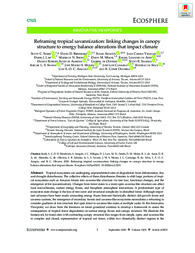Reframing tropical savannization: linking changes in canopy structure to energy balance alterations that impact climate.
Reframing tropical savannization: linking changes in canopy structure to energy balance alterations that impact climate.
Author(s): STARK, S. C.; BRESHEARS, D. D.; ARAGÓN, S.; VILLEGAS, J. C.; LAW, D. J.; SMITH, M. N.; MINOR, D. M.; ASSIS, R. L. de; ALMEIDA, D. R. A. de; OLIVEIRA, G. de; SALESKA, S. R.; SWANN, A. S.; MOURA, J. M. S.; CAMARGO, J. L.; SILVA, R. da; ARAGÃO, L. E. O. C.; OLIVEIRA JUNIOR, R. C. de
Summary: Tropical ecosystems are undergoing unprecedented rates of degradation from deforestation, fire, and drought disturbances. The collective effects of these disturbances threaten to shift large portions of tropical ecosystems such as Amazon forests into savanna like structure via tree loss, functional changes, and the emergence of fire (savannization). Changes from forest states to a more open savanna like structure can affect local microclimates, surface energy fluxes, and biosphere?atmosphere interactions. A predominant type of ecosystem state change is the loss of tree cover and structural complexity in disturbed forest. Although important advances have been made contrasting energy fluxes between historically distinct old growth forest and savanna systems, the emergence of secondary forests and savanna like ecosystems necessitates a reframing to consider gradients of tree structure that span forest to savanna like states at multiple scales. In this Innovative Viewpoint, we draw from the literature on forest?grassland continua to develop a framework to assess the consequences of tropical forest degradation on surface energy fluxes and canopy structure. We illustrate this framework for forest sites with contrasting canopy structure that ranges from simple, open, and savanna like to complex and closed, representative of tropical wet forest, within two climatically distinct regions in the Amazon. Using a recently developed rapid field assessment approach, we quantify differences in cover, leaf area vertical profiles, surface roughness, albedo, and energy balance partitioning between adjacent sites and compare canopy structure with adjacent old growth forest; more structurally simple forests displayed lower net radiation. To address forest?atmosphere feedback, we also consider the effects of canopy structure change on susceptibility to additional future disturbance. We illustrate a converse transition?recovery in structure following disturbance?measuring forest canopy structure 10 yr after the imposition of a drought in the ground breaking Seca Floresta experiment. Our approach strategically enables rapid characterization of surface properties relevant to vegetation models following degradation, and advances links between surface properties and canopy structure variables, increasingly available from remote sensing. Concluding, we hypothesize that understanding surface energy balance and microclimate change across degraded tropical forest states not only reveals critical atmospheric forcing, but also critical local scale feedbacks from forest sensitivity to additional climate linked disturbance.
Publication year: 2020
Types of publication: Journal article
Unit: Embrapa Eastern Amazon
Observation
Some of Embrapa's publications are published as ePub files. To read them, use or download one of the following free software options to your computer or mobile device. Android: Google Play Books; IOS: iBooks; Windows and Linux: Calibre.
Access other publications
Access the Agricultural Research Database (BDPA) to consult Embrapa's full library collection and records.
Visit Embrapa Bookstore to purchase books and other publications sold by Embrapa.

